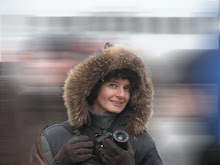Cut and Paste Mom on Mother's Day
 |
| Fig. 1: Nancy's mother and grandmother |
I remember stomping off to the Reichians for bioenergetic therapy after college, in the hopes that I could avenge a controlling childhood through "expressive exercises" like pillow-beating. I beat the pillow alright, but the more the counselor encouraged man-on-pillow violence, the more I couldn't stop my nervous laughter."...the proverbial 'hit the pillow to get aggression out against your spouse' has actually been shown to increase anger and resentment."
Basically, I discovered you can't blame an Obsessive Compulsive mother for being mentally ill any more than you can believe a pillow is a stand-in for your dysfunctional parent.
In the end, I found cutting and pasting (what today has become my digital photomontage work) much more therapeutic. Perhaps it's something about all the time us digital artists spend studying a face or a body, zooming in, carefully cutting out a figure rather than coloring inside the lines. And that's just the half of it. There's also the magic that occurs when you slide two combatants side by side, engaging them in imaginary conversation. Stare at the two of them long enough, and you'll swear they're getting along.
So cut and paste your mom on Mother's Day ... or leave it to the experts.
Nancy Gershman is a digital artist who offsets your losses and regrets by creating custom wishful reality from photos, memories and family stories. To order this meaningful photo gift in time for Mother's Day, contact Nancy at her studio Art For Your Sake or by emailing her at nancy@artforyoursake.com or 773-255-4677.


